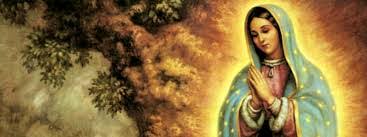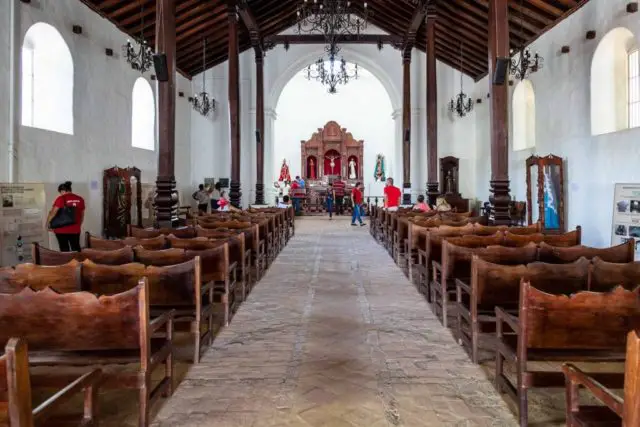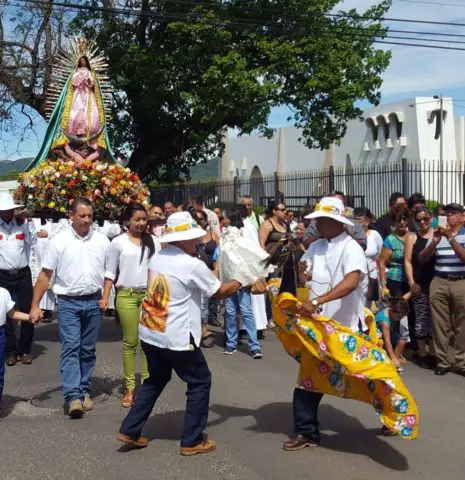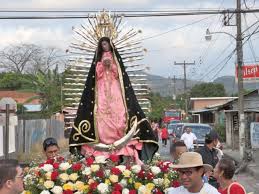Every year the Festivities of Our Lady the Virgin of Guadalupe are celebrated in Nicoya during November and December, which include different religious, cultural and even profane activities. Among these, it is possible to mention: La contadera de días (the day counter), La pica de leña (the woodpile), La atolada (the brothed), El alza de la ramada (the rise of the ramada), La Alborada (the dawn), La procesión de la pasada (the procession of the pass), La vastación de la imagen de la Virgen (the vastation of the image of the Virgin), El alba (the dawn), La elección (the election) and La procesión de las candelas (the procession of the flames). Here we tell you about this important cultural festivity in Costa Rica.

General and historical aspects
The Brotherhood of Our Lady of Guadalupe has a property located 200 meters east of the central park of Nicoya, which is known as “La Casa de la Virgen“, “La Casa de la Hermandad” or simply as “La Cofradía“. That is where the main activities that make up these colorful celebrations are carried out. This house was donated many years ago by a faithful devotee of the Virgin of Guadalupe, Mrs. Mariana Montiel de Pérez. All activities include the participation of the faithful devotees of the Virgin of Guadalupe, the brotherhood, the parish and a large part of the civilian population of the Nicoya community.

These holidays imply a centennial tradition inherited from the Chorotegas native ancestors, who recognized as their patron the Virgin of Guadalupe, whom they called “La Señorita”. This after the evangelizing processes carried out in the Nicoya region, with the arrival of the Spaniards in 1522.
Among the most important religious celebrations of the Chorotegas, the Fiesta del Sol stood out, in which with great solemnity they dedicated to their God the Sun, their crops and their maidens through collective dances and rites. The intake of fermented beverages was common. With the passage of time and the introduction by the Spaniards of the catholic catechism to the aborigines, this native festival was transformed into Feast of the Virgin of Guadalupe.
La Hermandad (the brotherhood)

The brotherhood of Our Lady the Virgin of Guadalupe has its beginnings in the devotion instilled in Nicoya after the appearance of the Virgin of Guadalupe to the Indian Juan Diego in Mexico in the year 1531. Following the beginnings of the celebrations in honor of the Virgin of Guadalupe, a religious congregation called “The Brotherhood of Our Lady the Virgin of Guadalupe” was born in the Nicoya region. People mainly from Matambú, Curime, Matambuguito, Quirimán, Las Casitas, Tierra Blanca, Río Grande, and Pueblo Viejo and around Nicoya, made their “ramada” procesion every year to Nicoya and spend the night in prayer and contemplation. Years later, a little house was donated by Mrs. Mariana Montiel.
At the beginning of the XXth century, the festivity was only done by the indigenous natives, but over time the tradition expanded to all the inhabitants. The religious festival involved processions like the ones done in the past, on December noon, but starting on November 1st, from eight in the morning in the House of the Brotherhood also called House of the Virgin, it consists in counting the days remaining for the “Celebro“, that’s what the natives called the main event on December 12th.
It is important to note that this countdown is made with corn grains of different colors: white, yellow and purple. This is done with the consent of the main officials who have a coordinating position within the celebrations: Mayordomos (butlers), Nacumenes, Prioste Mayor, Prioste Second, P. Third, P. Fourth, P. Fifth, Patron Alborada (dawn patron), Patron Vespertino (afternoon patron), Patron de Doce (midday patron), Patron de la Pasada de la Virgen a la Cofradía (patron of virgin passing from brotherhood), Patron de la Pasada de la Virgen a la Iglesia (patron of virgin passing to the church), Patron del Alba, Patron de Tercia, Diputados (deputies), Jarreras (water carriers), Cocineras (kitchen aids), Encargados de vestir a la Virgen (dressers), Mantenedores (maintainers), Escribanos (notaries), Comisarios, Mariscales (marshals), and of course devout people that are all those who want to participate in the ceremony.

Beginning of the activity: The Butler asks those present to take a seat, so that the Nacume proceeds to start counting the days remaining for the “celebration”, but not before having heard the sound of the “ocarinas” that characterize the Dance of the “Yegüita”.
The ceremony begins with great solemnity saying: “Gentlemen, as has been the custom of the indigenous people, we will proceed to count the days remaining for the celebration of the feast of Our Lady of Our Lady of Guadalupe“. Immediately he takes a cob from which pulling a grain for each day from the thirtieth of November, which he starts moving away, then starts twelve grains that symbolize the first twelve days of December to explain to those present that “there are thirty-twelve days left until the celebration”, then, taking the thirty grains of November and one by one gives them the name of the days of the week, according to which November 1st has fallen from which to complete the two weeks, that way the date of the second Saturday in which it will correspond to perform “pica e leña” (firewood cutting). After the ceremony of the day’s countdown, the appointment of the missing employees continues, namely: Persons in charge of: dressing the “Yegüita“, dressing the “Doll“, chargers of the “Yeguita”, Captain, Cashiers, Piteros (whistlers), Jarreras (water carriers), Cooks, “nizquezadoras” and kitchen helpers.

